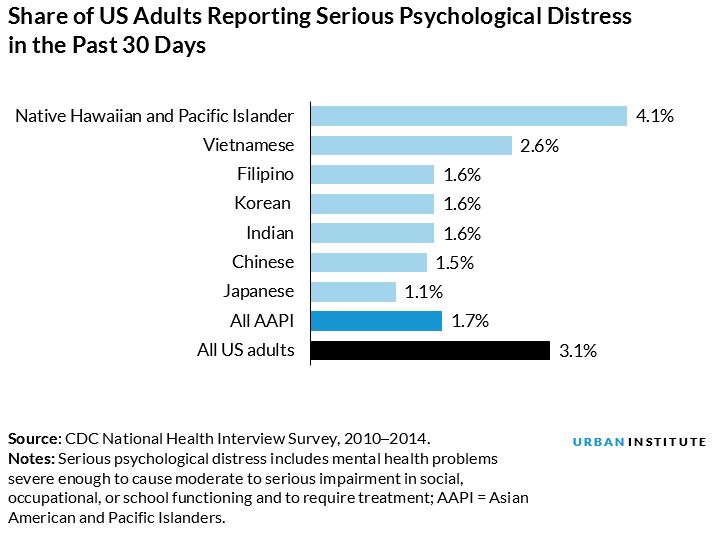
<p>Photo by Milkovasa via Shutterstock.</p>
Although the US has made progress in raising awareness of mental health and normalizing conversations about the topic, a great deal of stigma remains around mental illness and poor mental health, and many still face barriers to accessing services and supports.
Among Asian American and Pacific Islander (AAPI) communities, these issues are often shrouded by silence and shame, allowing misconceptions and minimization of mental health concerns to thrive.
But AAPIs are not a monolith. Our understanding of their mental health needs—and how we respond—should reflect the diversity of experiences within the AAPI community. Here’s what you should know about this important topic and underserved population this Mental Health Awareness Month and Asian Pacific American Heritage Month.
AAPIs are the least likely of any racial or ethnic group to report mental health issues and to seek mental health services
According to the National Survey on Drug Use and Health, AAPI adults report serious psychological distress at about half the rate of the US average—but there is wide variation between AAPI ethnic subgroups. Vietnamese Americans, Native Hawaiians, and Pacific Islanders report poor mental health at rates closer to the US average than to their AAPI counterparts.
There are also notable differences in mental health across immigration-related factors. Second-generation AAPIs were almost twice as likely to report a mental health disorder in the past year than first-generation immigrants.

But even after controlling for prevalence of mental illness, AAPI adults seek mental health services less than any other group. They are almost three times less likely than white adults to seek mental health services for unmet needs.

A 2015 Substance Abuse and Mental Health Services Administration study found AAPIs were more likely than people of other racial or ethnic identities to cite “low perceived need,” “structural barriers,” and “not thinking services would help” as reasons for not using mental health services.
AAPIs face cultural and structural barriers to accessing mental health services
Although there are deep-rooted systemic challenges with the American mental health care system as a whole—such as inadequate funding and support, uneven geographic distribution of services, and fragmented and uncoordinated service providers— certain cultural and structural barriers also affect service provision and quality of care for AAPI communities more specifically.
Culturally specific attitudes among AAPIs that stigmatize help-seeking include the following:
- The model minority myth. The assumption that all AAPIs experience educational success and economic stability can place immense pressure on people to meet these societal and familial expectations, often at the cost of their mental well-being.
- Generational experiences of hardship. Many first-generation AAPIs experienced trauma as immigrants or refugees adapting to life in a foreign land. As a result, younger generations often feel guilty about sharing their mental health struggles, fearing they may seem insignificant when compared with their parents’ and grandparents’ hardships.
- Lack of understanding about mental health. AAPIs, particularly first-generation immigrants, may not understand that mental health is part of a person’s overall well-being and can be treated just like other medical concerns. As a result, many older AAPIs deny or neglect mental health issues, explain symptoms in physical terms rather than psychological ones, or rely on social networks for support rather than seek professional services.
But even those who want to access mental health care may not be able to because of structural barriers:
- Low cultural competency among service providers. Service providers are not always trained to understand and address culturally specific mental health issues. This lack of competency has historically led to misdiagnosis and underdiagnosis of mental illness for AAPIs.
- Insufficient multilingual services. More than a third of AAPIs have limited English proficiency, and over 30 languages are spoken across AAPI communities. Nearly half of AAPIs will have difficulty accessing mental health treatment because they cannot find services that meet their language needs.
- Challenges with health care and insurance. Immigration status, financial obstacles, and high rates of uninsurance and underinsurance are also barriers to accessing affordable mental health services among AAPIs, as well as immigrants more broadly.
Culturally sensitive research can inform advocacy, legislation, and practice
Although there are clear limitations to current knowledge about AAPI mental health, as well as gaps in services, efforts are underway to advance AAPI mental health and well-being through advocacy, legislation, and research-informed practice.
As researchers, we should strive to gather meaningful and disaggregated data on AAPIs to understand the range of lived experiences and internalized beliefs that may undermine mental health or treatment and recovery from mental illness.
Thoughtful research that illuminates the scope and nature of mental health issues among AAPIs can inform culturally responsive policies and practices that reduce stigma and bridge the gap between AAPIs and mental health service providers.
Let’s build a future where everyone, everywhere has the opportunity and power to thrive
Urban is more determined than ever to partner with changemakers to unlock opportunities that give people across the country a fair shot at reaching their fullest potential. Invest in Urban to power this type of work.